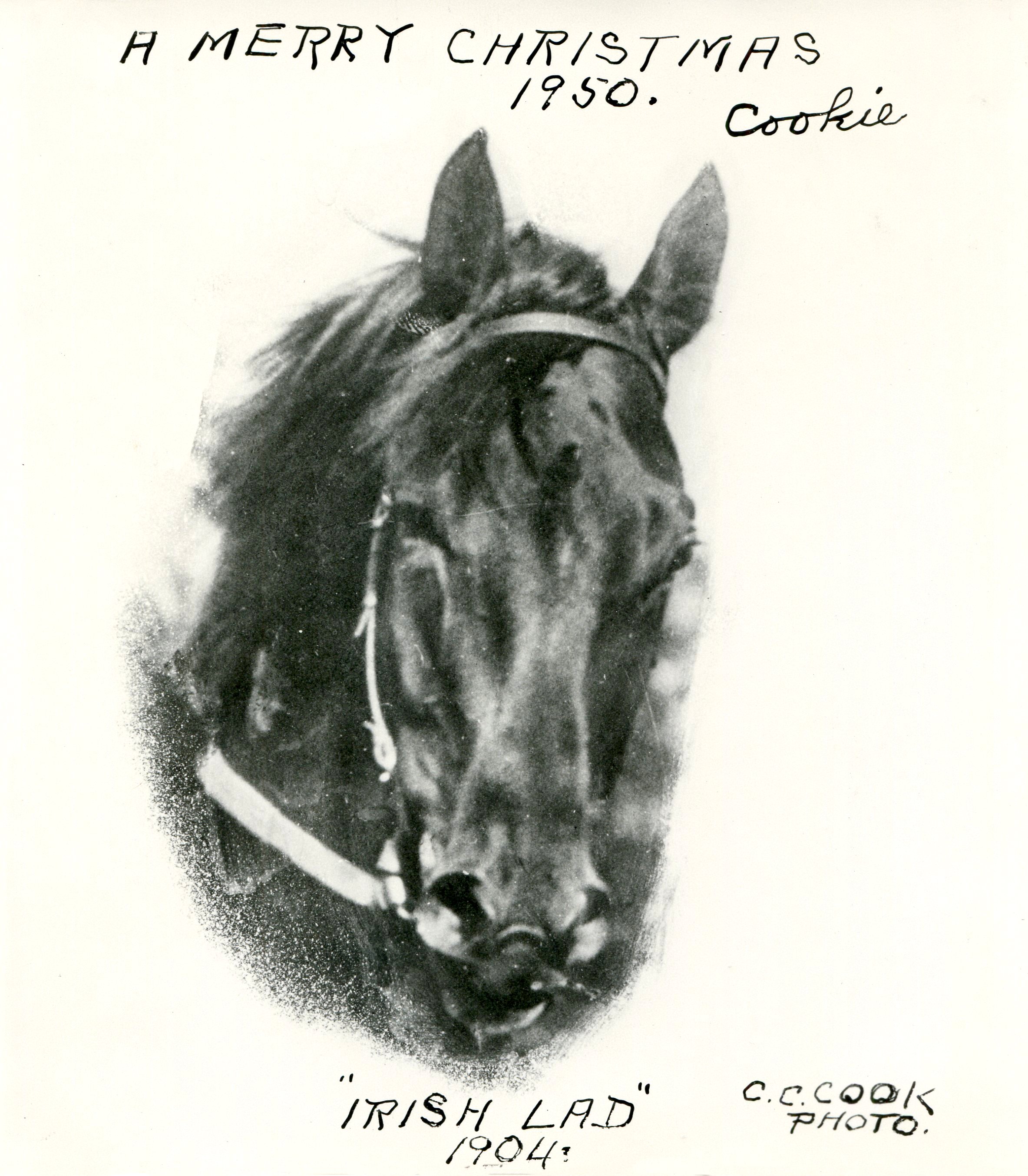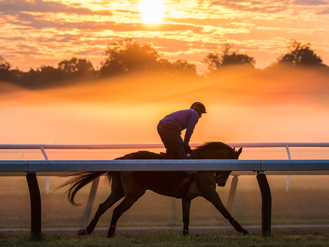Historical horse profile: Irish Lad

Champion 2-year-old of 1902 brought Harry Payne Whitey and Herman B. Duryea to prominence in American racing
By Brien Bouyea
Hall of Fame and Communications Dirctor
Harry Payne Whitney was just starting to dabble in thoroughbred racing when he purchased the promising colt Irish Lad in partnership with Herman B. Duryea in the spring of 1902. Bred by H. Eugene Leigh, Irish Lad was sold to John E. Madden as a yearling in the fall of 1901 for $2,550. Madden meticulously prepared Irish Lad for the races and received a healthy return on his investment when he resold the horse to Whitney and Duryea for $17,500.
One of the most accomplished horseman in American history, Madden stayed on as Irish Lad’s trainer for his juvenile campaign. A dark bay/brown son of Candlemas (GB) out of the Bramble mare Arrowgrass, Irish Lad competed for Whitney and Duryea under the banner of Westbury Stable. After finishing out of the money in his debut, Irish Lad quickly came to hand, breaking his maiden at second asking and winning five of his first seven starts in New York at Morris Park and Sheepshead Bay from May through June of 1902.
Irish Lad’s breakthrough victory was that year’s Great Trial Stakes. In what the New York Times described as “the most spectacular race of the season at the Sheepshead Bay track, when in one of the best races ever run by a two-year-old the $20,000 Great Trial Stakes was won on the post by Irish Lad, with the green and white colors of Harry Payne Whitney and H. B. Duryea up.” A crowd estimated at 20,000 or more was on hand for the six-furlong race. Mizzen, a bay son of Hastings owned by August Belmont II, was favored in the Great Trial at 6-5 and looked every bit the winner nearing the finish. Mizzen “held his place on the lead, in spite of the terrific pace he had carried, and even then fought out gamely, but within the last forty yards Irish Lad, coming with the rush of a rush of a fresh horse passed him,” said the Times.
When Irish Lad crossed the finish first there was “a most tremendous whoop from the clubstand by William C. Whitney in person, his shout of jubilation being one that would have done credit to the heartiest rooter on the lawn,” the Times reported. “Mr. Whitney expressed himself as more pleased to see his son’s horse win than he would have been to win another Futurity himself. With Whitney and Duryea shared the former owner and present trainer of the winner, John E. Madden, to whom will go $5,000 of the stake.”
Next up was Saratoga, where Irish Lad took aim at the six-furlong Saratoga Special. Mizzen was again favored, but Irish Lad had no trouble defeating the filly Dazzling by 1½ lengths. Mizzen was never a factor, finishing out of the money. The victory was worth $18,000 and a gold cup valued at $1,500.
Returning to Sheepshead Bay, Irish Lad was entered in the prestigious Futurity Stakes. Carrying high weight of 130 pounds, however, proved to be too much of a burden. Irish Lad ran gamely but finished sixth in the massive field of 24. A week later, he closed out his 2-year-old year on a high note with an impressive two-length victory in the Flatbush Stakes.
Although there were no formal championship honors until 1936, Irish Lad is generally recognized as the champion 2-year-old male for 1902. He concluded the year with seven wins — including three stakes — from 10 starts.
John W. Rogers took over Irish Lad’s training for his sophomore campaign in 1903. A showdown between father and son took place in late May at Sheepshead Bay in the Brooklyn Handicap. W. C. Whitney sent out Gunfire, retrospectively regarded as the champion 3-year-old filly of 1903, against his son’s Irish Lad.
“All interest centered in the great event of the day, the race for the Brooklyn Handicap, and William C. Whitney, lolling back in his box, seemed convinced that he held the key to the situation in the splendid mare Gunfire,” said the Times. “His son, Harry Payne Whitney, seemingly agreed with him, for all the friends of the Whitney family who sought tips on the race were told that Gunfire was never so good even when she won the Metropolitan Handicap as at this time.”
The race was a thriller. Irish Lad took the lead early and was all out when Gunfire stuck a head in front nearing the finish. Irish Lad, however, got the bob and the victory. The outcome was so close that “none save the judges could tell which was the winner,” reported the Times.
“It actually was what is known to racing men as a question of the nod,” the Times continued, “for Gunfire showed her head in front one jump from the post, but the stride being with Irish Lad, his head was in front again as they passed the winning post, and Irish Lad got the verdict by the narrowest of margins, while the excited thousands whooped in expectation and in ignorance of which was the actual winner.”
Irish Lad covered the 1¼-mile distance in 2:05⅖, setting a new stakes record. The Times was not shy in praising Irish Lad, describing his victory as the “most spectacular Brooklyn Handicap that has ever been run in the seventeen years of the race.”
Later that summer, Irish Lad returned to Saratoga and broke the track record for 1¼ miles in winning the Saratoga Champion Stakes by a length in 2:05. Hermis, winner of the 1902 Travers, finished second. Overall, Irish Lad wasn’t in top form as much as a 3-year-old as he was during his juvenile season. Along with the Brooklyn Handicap and Saratoga Champion Stakes, he won the Broadway Stakes, but those were his only victories of 1903.
Returning as a 4-year-old in 1904, Irish Lad battled a lesion on one of his legs and experienced intermittent soreness, but his past brilliance was still evident. He defeated Toboggan and Beldame in the Metropolitan Handicap before a crowd estimated at 30,000 in early May at Morris Park and set a world record on June 26 in the Advance Stakes, covering 1⅜ miles in 2:17⅗. Irish Lad, however, was injured in the Brighton Handicap a couple weeks later and retired.
Irish Lad attempted a comeback the following year but finished ninth in a handicap at Gravesend and was retired for good with a record of 12-5-2 from 33 starts and earnings of $99,250. Irish Lad had sired only a few horses in the United States when the Hart-Agnew anti-gambling law effectively shut down racing in New York. As a result, Irish Lad was sent to Duryea’s stud farm in France, where he went on to sire Banshee, winner of the 1913 Poule d’Essai des Pouliches (French One Thousand Guineas), and Pellsie, winner of the 1919 Prix de Diane (French Oaks). Irish Lad lived in France until his death at the age of 25 in 1925.
Harry Payne Whitney went on to become one of the most successful owners and breeders in racing history. He bred 192 stakes winners, including 20 recognized champions. Four of them — Regret, Equipoise, Top Flight, and Whish Broom II — were elected to the Hall of Fame. Whitney either bred or owned the winners of 10 Triple Crown races, including the Kentucky Derby with Regret, the first filly to win the race.
Duryea, meanwhile, also had great success following Irish Lad. After W. C. Whitney’s death in early 1904, Whitney’s horses ran for Duryea that year under a lease agreement. The stable topped the American earnings list at $200,107. Many of those horses were later purchased outright by Harry Payne Whitney, who was inducted into the Hall of Fame as a Pillar of the Turf in 2018.
Irish Lad (NY)
Lifespan: 1900 ̶ 1925
Pedigree: Candelmas (GB)—Arrowgrass, by Bramble
Breeder: H. Eugene Leigh
Owner: 1. John E. Madden; 2. Westbury Stable (Herman B. Duryea and Harry Payne Whitney)
Trainer: 1. John E. Madden; 2. John W. Rogers
Career dates: 1902 ̶ 1905
Record: 33 starts, 12 wins, 5 seconds, 2 thirds
Earnings: $99,250
Honors:
- Champion 2-Year-Old Male 1902
Notable:
- Won the 1902 Saratoga Special
- Won the 1903 Brooklyn Handicap at Gravesend in stakes-record time of 2:05⅖ for 1¼ miles
- Won the 1903 Saratoga Champion Stakes in track-record time of 2:05 for 1¼ miles
- Won the 1904 Advance Stakes at Sheepshead Bay in world-record time of 2:17⅗ for 1⅜ miles
- Won the 1904 Metropolitan Handicap at Morris Park




